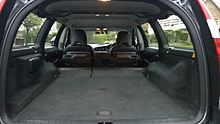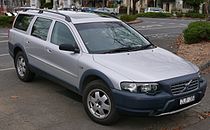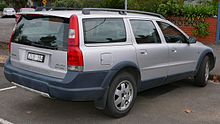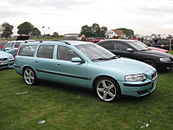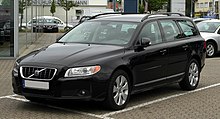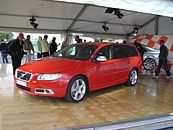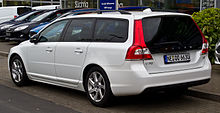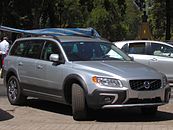Volvo V70
| Volvo V70 | |
|---|---|
 Volvo V70 (US) | |
| Overview | |
| Manufacturer | Volvo Cars |
| Also called | Volvo XC70 |
| Production | |
| Body and chassis | |
| Class |
|
| Body style | |
| Layout | Front engine, front-wheel drive or four-wheel drive |
| Chronology | |
| Predecessor | Volvo 850 |
| Successor | Volvo V90 II |
The Volvo V70 is an executive car manufactured and marketed by Volvo Cars from 1996 to 2016 across three generations. The name V70 combines the letter V, standing for versatility,[1][2] and 70, denoting relative platform size[3] (i.e., a V70 is a larger car than a V40, but smaller than a V90).
The first generation (1996–2000) debuted in November 1996[4][5] as the estate variant of the Volvo S70. Both cars were essentially redesigned Volvo 850s which had itself been available in saloon and estate configurations. The V70 was available as a front and all-wheel drive estate, the latter marketed as the V70 AWD. In 1997, a special AWD version called V70 Cross Country, badged as V70 XC, was presented and went on sale for model year 1998.
The second generation (2000–2007) shared styling by Peter Horbury[6] as well as major mechanical commonality with the Volvo S60 saloon and was based on the P2 platform. With a 4 cm increase in width and height, a 5 cm longer wheelbase, a slightly shorter overall length than its predecessor,[7] and a slightly increased interior cargo volume it went on sale in early 2000.[8] As with its predecessor, the second generation was also offered as an all-wheel drive variant which was marketed as the V70 AWD and as a special version called V70 XC, which for model year 2003 was renamed to XC70 .
The third generation (2007–2016) was based on the Volvo P3 platform, sharing general styling and much of the interior in front of the b-pillar with the second generation Volvo S80. It has been marketed since 2007 as the V70 and the XC70, a crossover model.
Production of the V70 ended on 25 April 2016, the XC70 continued until May 2016.[9]
First generation (1996–2000)
| First generation | |
|---|---|
 1999 Volvo V70 (AU) | |
| Overview | |
| Manufacturer | Volvo Cars |
| Also called | Volvo V70 XC |
| Production |
|
| Model years |
|
| Assembly | |
| Designer |
|
| Body and chassis | |
| Body style | 5-door estate |
| Platform | Volvo P80 platform |
| Related | Volvo S70 Volvo C70 |
| Powertrain | |
| Engine | Petrol: 2.0–2.5L I5 (93kW–195kW) Diesel: 2.5L I5 (103kW) |
| Transmission | |
| Dimensions | |
| Wheelbase |
|
| Length |
|
| Width | 1,761 mm (69.3 in) |
| Height |
|
| Curb weight | |
| Chronology | |
| Predecessor | Volvo 850 estate |
The first generation V70 was an improved development on the basis of the Volvo 850 estate.[17] Overall design became more rounded doing away with the 850's square edges. Among the many changes were a completely revised front end, fully painted bumpers and side trim and clear indicator lenses all around. Most of the interior was redesigned, with new seats, door panels and dashboard. According to Volvo a total of 1800[3][1] changes were made.[18] Standard equipment was significantly improved with remote central locking, heated & electrically adjustable mirrors, 2 front- and 2 sideairbags,[19] power brakes with ABS[19] and power windows being standard on every car.[20] Trim levels varied for each market as did equipment levels of the most basic trims. In the United States, the badging denoted the engine variant and to some extent the equipment level, whereas in Europe engines and options could be chosen individually. In all markets more powerful versions received better or upgraded standard equipment.[21] The T5 and R were the series high-performance models.[20]
For 1999 a minor facelift was introduced. Apart from very minor cosmetic changes like the square XC-style roof rails replacing the rounded version and a slightly changed logo for the front grill, it concentrated on the mechanicals. Volvo introduced its second generation side airbag[22] which was increased in volume to offer better protection.[23] WHIPS was also introduced as part of the standard equipment. New engine management systems with drive-by-wire throttle replaced the mechanical throttle on turbo models and an upgraded traction control now called STC was introduced. The ABS was upgraded from a three-channel to a four-channel system,[24] while all-wheel drive models received thicker rear discs and redesigned rear calipers. The 4-speed automatic transmissions were upgraded to adaptive shift logic.[24]
For the model year 2000, a new 5-speed automatic transmission[25] with adaptive shift logic was introduced. It was only available on non turbo front-wheel drive models and the 2000 V70 R AWD.[26] All 10V engines were dropped and replaced by detuned 20V versions. Drive-by-wire throttle was now also introduced for non turbo models.
First generation models
V70
The standard V70 was available with a wide variety of engines, gearboxes and equipment.[1] Standard configuration was front-wheel drive,[27] an all-wheel drive version[28] badged as V70 AWD[29][30] was available. For some markets Volvo offered a diesel version badged as V70 TDI.[31] In countries with high taxes on cars with more than 2.0L engine capacity, such as Italy, special petrol models with a 2000cc engine capacity were offered. This included a 2.0T and a 2.0L T5 version, the latter with a slightly lower power output than the 2.3L T5.
With the V70 Bi-Fuel[32][33] Volvo continued to offer a factory CNG[34] powered car. A 95-litre tank[35] installed in the trunk[36] allowed for a claimed range of 250 km[37] running on CNG only.[38] Due to the bulky tank rear cargo space was considerably reduced.[39] Drivers could choose whether their car should run on petrol or CNG at the touch of a button.[40] On Bi-Fuel models the temperature gauge in the instrument cluster was replaced by a level gauge for the gas tank.[41][42] Several options, such as a trip computer and sports suspension, were not available for Bi-Fuel models. Neither Bi-Fuel nor TDI were offered on the North American market.[43]
Specialised vehicles, such as taxi and police versions, were also available directly from the factory. Changes included preparations to install additional equipment, a certified calibrated speedometer, uprated brakes[44] with wear indicators[45][46] and a different level of standard equipment.
An optional third row seat increased occupant capacity from 5 to 7 seats while reducing underfloor storage space in the trunk.[47]
-
Volvo V70 (DE)
-
Volvo V70 (AU)
V70 XC
The V70 XC was introduced in September 1997[48][49] on the Frankfurt Auto Show for the 1998[29] model year[50] as a crossover version of the V70. It featured standard all-wheel drive[51] and was available with only two engine and gearbox choices.[29] In the US only the 2.4L turbo engine together with an automatic gearbox was available.[52][53][54] A 2.0L version of the V70 XC was available only for markets with high taxes on cars with more than 2000cc engine capacity.[55] Standard ride height was increased[56]by 2.6cm[57] over the regular AWD model.[58] Visual differences from a standard V70 AWD include a unique front and rear bumper, unpainted sidetrim and sills, a squarer version of the roof rails,[59] a unique front grille[59] and a big Cross Country decal across the tailgate. Buyers could also specify a two tone exterior colour.[60] Interior details included thicker floor mats and revised base seat covers.
-
Volvo V70 XC (US)
-
Volvo V70 XC (US)
V70 R
As the replacement for the popular 850 T-5R and 850 R, the V70 R[29] was unveiled in May 1997. Similar to the previous generation R models it featured a unique leather/alcantara[1] interior with diamond stitching[61] on the seats.[20] Further styling touches were a special front bumper, blue gauge faces for the instrument cluster,[61] two special colours and special alloy wheels. All US cars were equipped with 16" alloy wheels,[62] other markets had 17" wheels available at extra cost or as standard equipment. Standard equipment was substantially upgraded[1] over normal models with few options available such as a trunk mounted CD-changer,[63] RTI[64] navigation system[65] or an upgraded stereo system. Intended to be the high performance version of the model range, all R models are fitted with the highest performance engines of the line up. Available in both front-wheel drive and all-wheel drive with either automatic or manual transmission. A redesigned suspension with lower ride height and firmer shocks was standard.[20] Three different versions were produced, depending on the model year.
For 1998 the R was available in 6 colours:[nb 1] Black Stone, Nautic Blue, Silver Metallic, Coral Red, Regency Red, Saffron. All apart from the first one were metallic paints[1] with Saffron only being available for the V70 R.[66] Versions offered included FWD & AWD, both with automatic or manual transmission. Automatic transmission cars were rated at 240 PS,[52] manual transmission cars featured a bigger turbo bumping up power by 10 PS to 250 PS and torque to 350NM. FWD manual transmission equipped R featured a viscous based limited-slip differential.[1] For the US no FWD or manual transmissions were offered.
For 1999 the R was available in 7 colours:[nb 2] Black Stone, Nautic Blue Pearl, Silver Metallic, Cassis, Venetian Red Pearl, Dark Olive Green, Laser Blue.[68] All apart from the first one were metallic paints with Laser Blue being only available on the R.[69] FWD and manual transmissions were no longer available, only AWD in combination with a 4 speed automatic. Cars were badged V70 R AWD. Power was increased to 250 PS.[53] Blue engine covers were introduced for R models.
For 2000 the R was available in 6 colours: Black Stone, Nautic Blue Pearl, Silver Metallic, Venetian Red Pearl, Dark Olive Green, Laser Blue.[70] All apart from the first one were metallic paints with Laser Blue being only available on the R. A new 2.4L engine was introduced and power increased to 265 PS[71] by use of a larger turbo and VVT.[54] The only available transmission was a newly introduced 5-speed adaptive automatic,[70] rear brakes were upgraded to vented discs unique to the R.[72] A dual outlet exhaust[73] was fitted as standard with the rear bumper being modified to accommodate it.[70] The interior could now be ordered in a two tone design which paired white alcantara and black leather for the seat covers.
-
Volvo V70 R front (SE)
-
Volvo V70 R rear (SE)
-
V70 R interior (UK)
-
V70 R interior showing blue faced gauges (UK)
Engines
| Model | Engine code | Year(s) | Power | Torque @rpm | Displacement | 0–100 km/h (0–62 mph) |
|---|---|---|---|---|---|---|
| 2.0 10V | B5202FS | 1997–1998 | 126 PS (93 kW; 124 hp) | 170 N⋅m (130 lb⋅ft) @4800 | 1,984 cc (121.1 in3) |
|
| 2.5 10V | B5252FS | 1997–1999 | 144 PS (106 kW; 142 hp) | 206 N⋅m (152 lb⋅ft) @3300 | 2,435 cc (148.6 in3) |
|
| 2.5 20V | B5254FS | 1997–1999 | 170 PS (125 kW; 168 hp) | 220 N⋅m (160 lb⋅ft) @3300 | 2,435 cc (148.6 in3) |
|
| 2.5 20V | B5254S[74] | 1999 | 170 PS (125 kW; 168 hp) | 220 N⋅m (160 lb⋅ft) @3300 | 2,435 cc (148.6 in3) |
|
| 2.0T | B5204T2 | 1997–2000 | 180 PS (132 kW; 178 hp) | 240 N⋅m (180 lb⋅ft) @1800 | 1,984 cc (121.1 in3) | |
|
B5254T[74] | 1997–1999 | 193 PS (142 kW; 190 hp) | 270 N⋅m (200 lb⋅ft) @1800 | 2,435 cc (148.6 in3) |
|
|
B5244T | 2000[75] | 193 PS (142 kW; 190 hp) | 270 N⋅m (200 lb⋅ft) @1800 | 2,435 cc (148.6 in3) |
|
| T5 2.0 | B5204T3 | 1997–1999 | 225 PS (165 kW; 222 hp) | 310 N⋅m (230 lb⋅ft) @2700 | 1,984 cc (121.1 in3) | |
| T5 2.3 | B5234T3[76] | 1997–2000 | 240 PS (177 kW; 237 hp) | 330 N⋅m (240 lb⋅ft) @2700 | 2,319 cc (141.5 in3) |
|
|
B5234T4 | 1998 | 250 PS (184 kW; 247 hp) | 350 N⋅m (260 lb⋅ft) @2400–5000 | 2,319 cc (141.5 in3) |
|
| R FWD (Auto) | B5234T3[76] | 1998 | 240 PS (177 kW; 237 hp) | 330 N⋅m (240 lb⋅ft) @2700–5100 | 2,319 cc (141.5 in3) |
|
| R AWD (Auto) | B5234T6 | 1998 | 240 PS (177 kW; 237 hp) | 310 N⋅m (230 lb⋅ft) @2400–5400 | 2,319 cc (141.5 in3) |
|
| R AWD (Auto) | B5234T8[74] | 1999 | 250 PS (184 kW; 247 hp) | 350 N⋅m (260 lb⋅ft) @2400 | 2,319 cc (141.5 in3) |
|
| R AWD (Auto) | B5244T2[76] | 2000 | 265 PS (195 kW; 261 hp) | 400 N⋅m (300 lb⋅ft) @2500 | 2,435 cc (148.6 in3) |
|
| Model | Engine code | Year(s) | Power | Torque @rpm | Displacement | 0–100 km/h (0–62 mph) |
|---|---|---|---|---|---|---|
| TDI* | D5252T (MSA 15.7)[78] | 1997–1999 | 140 PS (103 kW; 138 hp) | 290 N⋅m (210 lb⋅ft) @1900 | 2,460 cc (150.1 in3) |
|
| TDI* | D5252T (MSA 15.8)** | 1999–2000 | 140 PS (103 kW; 138 hp) | 290 N⋅m (210 lb⋅ft) @1900 | 2,460 cc (150.1 in3) |
|
| Model | Engine code | Year(s) | Power | Tourqe @rpm | Displacement | 0–100 km/h (0–62 mph) |
|---|---|---|---|---|---|---|
| Bi-Fuel | GB5252S | 1997–1998 | 144 PS (106 kW; 142 hp) 122 PS (90 kW; 120 hp) |
206 N⋅m (152 lb⋅ft) @3600 180 N⋅m (130 lb⋅ft) @3600 |
2,435 cc (148.6 in3) |
|
| Bi-Fuel | GB5252S2 | 1999 | 144 PS (106 kW; 142 hp) 122 PS (90 kW; 120 hp)[42] |
206 N⋅m (152 lb⋅ft) @3600 180 N⋅m (130 lb⋅ft) @3650 |
2,435 cc (148.6 in3) |
|
| Bi-Fuel | B5244SG | 2000 | 140 PS (103 kW; 138 hp) | 192 N⋅m (142 lb⋅ft) @3300 | 2,435 cc (148.6 in3) |
|
- *Volvo used a modified version of the 2.5 TDI VAG engine[79]
- **For 1999 the engine management system was updated to comply with emission regulations
Safety
A driver airbag was standard equipment on all V70 models, depending on the market a passenger airbag was either standard equipment or a no cost option. Seatbelt pretensioners for both driver and passenger were always part of the standard equipment. SIPS was standard on all V70 models. The system is supplemented by standard side airbags incorporated into the front seats.[80]
Euro NCAP evaluated the S70 (saloon variant of V70) in 1998 awarding it 4 of 5 stars for adult occupant protection. The S70 scored 7 of 16 points in the front test, and 16 of 16 in the side test. The car received 2 of 2 points available in the pole test. The S70 received a total of 25 of 37 points and therefore four stars (25–32) in Euro NCAP's evaluation.[81]
The S70 scored five of five stars for front impact protection for driver and front passenger in the U.S. National Highway Traffic Safety Administration (NHTSA) safety testing, and four out of five stars for driver and rear passenger side impact protection.[82]
The Insurance Institute for Highway Safety (IIHS) granted the 850/S70 their highest rating of "good" for front crash protection. Rear crash protection was rated as "good".[83][84] 1999 and newer, prevents whiplash by a seatback hinge mechanism that is standard equipment. There were no side impact tests conducted on behalf of the IIHS for the Volvo V70.
Second generation (2000–2007)
| Second generation | |
|---|---|
 2001 Volvo V70 (AU) | |
| Overview | |
| Manufacturer | Volvo Cars |
| Also called |
|
| Production | January 2000–2007[4] |
| Model years |
|
| Assembly |
|
| Designer | Peter Horbury |
| Body and chassis | |
| Body style | 5-door estate |
| Platform | Volvo P2 platform |
| Related | |
| Powertrain | |
| Engine | Petrol: 2.0–2.5L I5 (103kW–221kW) Diesel: 2.4–2.5L I5 (93kW–126kW) |
| Transmission | |
| Dimensions | |
| Wheelbase |
|
| Length |
|
| Width |
|
| Height |
|
| Curb weight | |
Volvo released the second generation V70 to most markets in early 2000,[89] and for the model year 2001 in North America. Based on the Volvo P2 platform, the second generation shared major mechanical and styling commonality with the Volvo S60 saloon, offered frontal area of 2.23 m2[90] and a coefficient of drag of .30.[91] The new generation featured adhesively bonded construction (vs. spot-welded) in key areas, with Volvo claiming the new body to be 70 per cent more rigid than the predecessor.[7] Critical aspects of the design for the second generation were completed before Ford acquired Volvo in 1999.[8]
The interior featured raised seating in the second row,[7] a hard point on the passenger’s side of the center console to provide support for a range of optional accessories (e.g., an optional shopping bag holder),[7] rear-seat table, waste basket and cargo net integrated into the rear seat backs.[92] Standard interior features included a coat hook integrated into the side of the front passenger's headrest, glove compartment with pen holder and toll card, configurable center console and rear seating with a two position backrests — one position favoring cargo and the other favoring comfort.[92]
All P2 platform Volvos received a minor facelift across all markets for 2005. The front fascia was redesigned, tail lamps & head lamps were changed to clear covers, the center console and dashboard received detail changes. Some minor changes were done to the electrical system and some engines, for example diesel engined models received a particle filter. A new 6-speed automatic transmission was introduced, available in both AWD and FWD configurations. Production of the second generation V70 and XC70 ended with the 2007 model year.
Styling
The second generation V70 was styled by British designer Peter Horbury, who said "the design challenge involved marrying sports car style at the front with the necessary limitations of a wagon back." [92] More specifically, he described the concept as the "front end of a Jaguar E-Type married to the back end of a Ford Transit van."[91]
The V70 of 2000 was the best combination of functionality on the back of the car, where you need it, and a very nice, elegant, sporty soft, voluptuous front that blended into that functionality — showing you can have both. – Peter Horbury[93]
Second generation models
V70
A second generation V70 Bi-Fuel was made available. LPG storage capacity was increased to a total of 100 litres, split into one 75 litre tank and two 12.5 litres tanks. Unlike before they were now installed at the underside of the car, therefore keeping all of the trunk space available.[94] Bi-Fuel models were only sold with the 2.4L (140PS) non turbo engine,[95] and a choice between a 5-speed manual or a 5-speed automatic transmission
-
Volvo V70 pre-facelift (US)
-
Volvo V70 post facelift (US)
-
Volvo V70 post facelift (JP)
-
Volvo V70 load area with rear seats folded flat (UK)
-
Volvo V70 Interior (EU)
V70 XC / XC70
At its introduction, the second generation V70 XC[96] received a major upgrade. It featured better ground clearance of 8.2 in (210 mm) [96] thanks to a raised suspension, different bodywork with unpainted bumpers and fender extensions and AWD as standard. An interior grab handle for the front passenger was installed only on this model. Early V70 XC featured special rear view mirrors, a feature that was discontinued after 2003.
Engine and gearbox choices were limited. Only the 2.5 low pressure turbo and D5 diesel engine with either a 5-speed manual or 5-speed automatic transmission were available, for the North American market no diesel version was offered.
For 2003 the model was renamed to XC70, in keeping with Volvo's newly introduced XC90.
-
Volvo V70 XC prior to renaming (DE)
-
Volvo XC70 pre-facelift (AU)
-
Volvo XC70 pre-facelift (AU)
-
Volvo XC70 post facelift (CA)
-
Volvo XC70 post facelift (CHL)
V70 / XC70 Ocean Race
In 2001, to mark their sponsorship of the just renamed Volvo Ocean Race,[97] special Ocean Race editions of the V70 and V70 XC[98] were announced. Released for model year 2002[99] the cars only came painted in a unique shade of blue. Silver exterior trim and roofrails as well as assorted badging set the models apart from non OR models.
For 2005 Volvo revived the V70 and XC70 Ocean Race Editions[100] were unveiled in early 2005. Once again all cars were painted in a unique shade of blue, had upgraded standard equipment and special styling touches such as specific alloy wheels, blue interior trim,[101] leather seats with contrast stitching[101] and Ocean Race badges on the outside.[102]
-
Volvo V70 XC Ocean Race pre-facelift (DE)
-
Volvo XC70 Ocean Race post facelift (CH)
V70 R
As with the previous generation, Volvo offered a high performance variant called V70 R AWD.[103] Based on the PCC2[104] concept car from 2001, the model was unveiled at the 2002 Paris autoshow on September 26.[105] Released in 2003[106] the model pioneered many firsts for Volvo. It was only available with a Haldex based all-wheel drive system and a 2.5L turbocharged five cylinder engine rated at 300 metric horsepower (221 kW; 296 hp) and 400 newton-metres (295 lbf⋅ft) of torque. This allowed for a 0–60 time of 5.9 seconds[106] and an electronically limited topspeed of 250 km/h. The R was available with a six-speed manual[107] or a five-speed automatic.[108] The 2005 facelift saw the five-speed automatic replaced by a more modern six-speed unit. Large brakes made by Brembo[109] provide high performance braking capabilities in line with the cars high performance characteristics. The V70 R comes as standard with Volvo's 4C[110] multi-mode suspension that had been developed in conjunction with suspension experts Öhlins. The driver may choose from three different settings to vary the car's handling depending on driving style and conditions.
In a 2006 article titled The Manwagon, The Wall Street Journal linked the V70R to a trend "to lure speed-crazy guys with kids," saying "car makers are trying to transform the dowdy old family hauler into something new,"[111] and that "consumer research had unearthed a surprising number of family men who thought wagons could be cool, if only they had more guts."[111]
A total of 3407 V70Rs were shipped to North America (2004= 1,565, 2005= 674, 2006= 823, 2007= 345).[112]
-
Volvo V70 R AWD pre-facelift (SWE)
-
Volvo V70 R AWD post facelift (US)
Engines
| Model | Engine code | Year(s) | Power | Torque @rpm | Displacement | Comment |
|---|---|---|---|---|---|---|
| 2.0T | B5204T | 2000–2004 | 163 PS (120 kW; 161 hp) | 240 N⋅m (180 lb⋅ft) @2200–4800 | 1,984 cc (121.1 in3) | Inline 5 with low-pressure turbo |
| 2.0T | B5204T5[113] | 2004–2008 | 180 PS (132 kW; 178 hp) | 240 N⋅m (180 lb⋅ft) @2200–5000 | 1,984 cc (121.1 in3) | Inline 5 with low-pressure turbo |
| 2.4 | B5244S2[113] | 2001–2007 | 140 PS (103 kW; 138 hp) | 220 N⋅m (160 lb⋅ft) @3300 | 2,435 cc (148.6 in3) | Inline 5 |
| 2.4 | B5244S | 2001–2003 | 170 PS (125 kW; 168 hp) | 230 N⋅m (170 lb⋅ft) @4500 | 2,435 cc (148.6 in3) | Inline 5 |
| 2.4 | B5244S[113] | 2003–2007 | 170 PS (125 kW; 168 hp) | 225 N⋅m (166 lb⋅ft) @4500 | 2,435 cc (148.6 in3) | Inline 5 |
|
B5244T3 | 2000–2003 | 200 PS (147 kW; 197 hp) | 285 N⋅m (210 lb⋅ft) @1800–5000 | 2,435 cc (148.6 in3) | Inline 5 with low-pressure turbo |
|
B5254T2[113] | 2003–2008 | 210 PS (154 kW; 207 hp) | 320 N⋅m (240 lb⋅ft) @1500–4500 | 2,521 cc (153.8 in3) | Inline 5 with low-pressure turbo |
| T5 | B5234T3[113] | 2000–2004 | 250 PS (184 kW; 247 hp) | 330 N⋅m (240 lb⋅ft) @2400–5200 | 2,319 cc (141.5 in3) | Inline 5 with high-pressure turbo |
| T5 | B5244T5 | 2004–2007 | 260 PS (191 kW; 256 hp) | 350 N⋅m (260 lb⋅ft) @2100–5000 | 2,401 cc (146.5 in3) | Inline 5 with high-pressure turbo |
| R AWD (5-speed automatic) |
B5254T5 | 2004–2006 | 300 PS (221 kW; 296 hp) | 350 N⋅m (260 lb⋅ft) @1800–6000 | 2,521 cc (153.8 in3) | Inline 5 with high-pressure turbo |
| R AWD (6-speed automatic) |
B5254T4 | 2006–2007 | 300 PS (221 kW; 296 hp) | 400 N⋅m (300 lb⋅ft) @1950–5250 | 2,521 cc (153.8 in3) | Inline 5 with high-pressure turbo |
| R AWD (manual) |
B5254T4[113] | 2004–2007 | 300 PS (221 kW; 296 hp) @5500 | 400 N⋅m (300 lb⋅ft) @1950–5250 | 2,521 cc (153.8 in3) | Inline 5 with high-pressure turbo |

| Model | Engine code | Year(s) | Power | Torque @rpm | Displacement | Comment |
|---|---|---|---|---|---|---|
| 2.5D (TDI) | D5252T | 2000–2001 | 140 PS (103 kW; 138 hp) | 290 N⋅m (210 lb⋅ft) @1900 | 2,460 cc (150.1 in3) | Inline 5 with turbo (VAG/Audi engine) |
| 2.4D | D5244T2[113] | 2001–2005 | 130 PS (96 kW; 128 hp) @4000 | 280 N⋅m (210 lb⋅ft) @1750–3000 | 2,401 cc (146.5 in3) | Inline 5 with turbo |
| D5 D5 AWD |
D5244T[113] | 2001–2005 | 163 PS (120 kW; 161 hp) @4000 | 340 N⋅m (250 lb⋅ft) @1750–3000 | 2,401 cc (146.5 in3) | Inline 5 with turbo |
| 2.4D | D5244T7[114] | 2005–2007 | 126 PS (93 kW; 124 hp) @4000 | 300 N⋅m (220 lb⋅ft) @1750–2250 | 2,400 cc (146.5 in3) | Inline 5 with turbo |
| 2.4D | D5244T5[114] | 2005–2007 | 163 PS (120 kW; 161 hp) @4000 | 340 N⋅m (250 lb⋅ft) @1750–2750 | 2,400 cc (146.5 in3) | Inline 5 with turbo |
|
D5244T4[114] | 2005–2007 | 185 PS (136 kW; 182 hp) @4000 | 400 N⋅m (300 lb⋅ft) @2000–2750 | 2,400 cc (146.5 in3) | Inline 5 with turbo |
| Model | Engine code | Year(s) | Power | Torque @rpm | Displacement | Comment |
|---|---|---|---|---|---|---|
| Bi-Fuel CNG | B5244SG[113] | 2001–2008 | 140 PS (103 kW; 138 hp) @4500 140 PS (103 kW; 138 hp) @5800 |
220 N⋅m (160 lb⋅ft) @3750 192 N⋅m (142 lb⋅ft) @4500[115] |
2,435 cc (148.6 in3) | Inline 5 for methane/petrol (biogas or natural gas). |
| Bi-Fuel LPG | B5244SG2[113] | 2002–2005 | 140 PS (103 kW; 138 hp) @4500 140 PS (103 kW; 138 hp) @5100 |
220 N⋅m (160 lb⋅ft) @3750 214 N⋅m (158 lb⋅ft) @4500[116] |
2,435 cc (148.6 in3) | Inline 5 for autogas/petrol (LPG/autogas). |
Engines for the P2 V70 generation featured an optional "ozone-eating" catalytic coating for their radiators, marketed as PremAir, which converted ground-level ozone into pure oxygen under normal vehicle operation — with maximum effect in urban traffic and strong sunlight.[90]
Safety
Euro NCAP evaluated the S60 (saloon variant of V70) in 2001 awarding it 4 of 5 stars for adult occupant protection. The S60 scored 10 of 16 points in the front test and 16 of 16 in the side test. The car received 2 of 2 points available in the pole test. The S60 received a total of 28 of 37 points and therefore four stars (25–32) in Euro NCAP's evaluation.[117]
The Insurance Institute for Highway Safety (IIHS) evaluated the Volvo S60 (saloon variant). The S60 was granted the IIHS's highest rating of "good" in front and rear tests. The S60 was awarded the Institute's second highest rating of "acceptable" in the side test. However, an improvement in the driver dummy's pelvis/leg rating from "marginal" to "acceptable" would yield an overall "good" rating in the side test.[118]
Third generation (2007–2016)
| Third generation | |
|---|---|
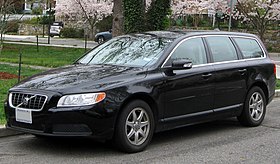 2008 Volvo V70 (US) | |
| Overview | |
| Manufacturer | Volvo Cars |
| Also called | Volvo XC70 |
| Production | 2007–2016[119][120] |
| Model years | 2008–2016[121] |
| Assembly |
|
| Body and chassis | |
| Body style | 5-door estate |
| Platform | Volvo P3 platform |
| Related | |
| Powertrain | |
| Engine | Petrol: 1.6–2.0L I4 2.0–2.5L I5 2.9–3.2L I6 (107kW–224kW) Diesel: 1.6–2.0L I4 2.0–2.5L I5 (85kW–158kW) |
| Transmission | |
| Dimensions | |
| Wheelbase |
|
| Length |
|
| Width |
|
| Height |
|
| Curb weight |
|
On February 2, 2007 Volvo debuted the third generation for 2008. Based on the Volvo P3 platform it shares a lot of parts and general styling with the second generation Volvo S80. Compared with its predecessor the rear-seat legroom was increased by two centimetres and a revised tailgate design increased the load area volume by 55 L. The V70 was offered for the first time with four-cylinder engines and six-cylinder engines. The high performance V70R AWD models were discontinued with this third generation, only a mostly cosmetic R-design package is available.
After model year 2011, Volvo discontinued sales of the V70 in North America, where it continues to market the XC70 and offers a FWD version as a quasi V70 replacement.[124]
The Sensus infotainment known from the Volvo XC60 was first made available in 2011 on the V70 and XC70.[125] For 2012 the V70 and XC70 received a minor facelift.[126] The front received a redesigned bumper with chrome accents, the Volvo logo on the front grill was enlarged. The indicators in the side mirrors were redesigned and changed to LED and the rear light cluster redesigned. New optional alloy wheels and exterior paint options were added.
Third generation models
V70
-
Volvo V70 pre-facelift (DE)
-
Volvo V70 pre-facelift (DE)
-
Volvo V70 R-Design (SE)
-
Volvo V70 post first facelift (DE)
-
Volvo V70 post second facelift (DE)
-
Volvo V70 post second facelift (DE)
-
Interior pre-facelift (SE)
V70 Plug-in Hybrid
As part of a joint venture with Vattenfall,[127] a Swedish energy company, Volvo converted two Volvo V70 to diesel-electric plug-in hybrid demonstrators[128] that have been in field testing in Göteborg, Sweden, since December 2009.[129] Vattenfall offered customers participating in this trial the supply of renewable electricity generated from wind power or hydropower.[130] Among other challenges, this test has allowed to experience the all-electric range at low temperatures, which has been a disadvantage of plug-in vehicles.[129][130]
The V70 PHEV test car uses an 11.3 kWh lithium-ion battery pack.[131] As reported by the test drivers, the V70 Plug-in Hybrid demonstrators have an all-electric range between 20 kilometres (12 mi) to 30 kilometres (19 mi). The demonstrators were built with a button to allow test drivers to manually choose between electricity or diesel engine power at any time.[129][132] The first phase of the field trial ended in June 2010 and included 16 families, all employees of Volvo or Vattenfall, who had the car for 1.5 weeks to one month. A second phase of the test goes from July to December 2010 with Vattenfall employees in Göteborg and Stockholm. Among the key findings of the first phase are:[129][132]
- Most drivers chose to use electricity in city traffic at lower speeds, but switched to diesel for highway driving.
- Test drivers found that 20 to 30 km was not enough all-electric range, and called for at least 50 kilometres (31 mi), some want 80 kilometres (50 mi) and even up to 150 to 200 kilometres (93 to 124 mi).
- All of the test drivers charge on a daily basis but none ever used the public charging station installed for the trial.
- Before the test trials, drivers were concerned about being a danger to pedestrians and cyclists due to the quietness of the electric-drive vehicle. After the test several of them changed their opinion and said that this issue was less of a problem than expected.
Volvo announced in 2009, and confirmed in 2010, the launching of series production diesel-electric plug-in hybrids as early as 2012.[133] Volvo claimed that its plug-in hybrid could achieve 125 miles per US gallon (1.88 L/100 km; 150 mpg‑imp), based on the European test cycle.[132][134]
Ultimately production of the V70 Plug-in Hybrid did not commence and the model was never commercially available.
XC70
As with previous generation models the XC70 features increased ground clearance, optional all-wheel-drive and some cosmetic differences from the normal V70. On the outside there are XC-only front and rear bumpers, side skirts, wheel arch extensions and additional exterior door trims all in unpainted black plastic. The optional roof rails feature an embossed "XC" and are only available in black. Various unique alloy wheels are offered only for the XC.
For the third generation XC a new feature called hill-descent-control was introduced that limits vehicle speed when driving down a steep embankment.[135]
-
Volvo XC70 pre-facelift
-
Volvo XC70 pre-facelift (AU)
-
Volvo XC70 post facelift (CHL)
-
Volvo XC70 post facelift (CA)
V70 / XC70 Ocean Race
In 2011[136] "Ocean Race Edition" versions of the V70 and XC70 were unveiled. All cars featured special interior trim, decor and details. Exterior colurs were limited to "Ocean Race Blue Metallic" or "Electric Silver Metallic".[137] Engine choices were limited to the D5 or T6.[138] For 2014 Ocean Race models were updated with detail changes such as different door sill plates, high gloss black mirror caps and front grill.[139]
Engines
The V70 and XC70 are available with various engine configurations:
| Model | Engine code | Year(s) | Power | Torque @rpm | Displacement | Comment |
|---|---|---|---|---|---|---|
| 2.0 | B4204S3[140] | 2007–2010 | 145 PS (107 kW; 143 hp) | 190 N⋅m (140 lb⋅ft) @ | 1,999 cc (122.0 in3) | Inline 4 |
| 2.0F | B4204S4[141] | 2007–2010 | 145 PS (107 kW; 143 hp) | 190 N⋅m (140 lb⋅ft) @ | 1,999 cc (122.0 in3) | Inline 4 Flexifuel |
| 2.0T[142] | B4204T6[142] | 2010–2011 | 203 PS (149 kW; 200 hp) | 300 N⋅m (220 lb⋅ft) @ | 1,999 cc (122.0 in3) | Inline 4 with turbo |
| 2.5T 2.5T AWD |
B5254T6[140][140] | 2007–2009 | 200 PS (147 kW; 197 hp) | 300 N⋅m (220 lb⋅ft) @1500 | 2,521 cc (153.8 in3) | Inline 5 with turbo |
| 2.5T[143] 2.5T AWD[143] |
B5254T10[143] | 2010–2011 | 231 PS (170 kW; 228 hp) | 340 N⋅m (250 lb⋅ft) @2800 | 2,521 cc (153.8 in3) | Inline 5 with turbo |
| 2.5FT[140] 2.5FT AWD |
B5254T8[140] | 2007–2009 | 200 PS (147 kW; 197 hp) | 300 N⋅m (220 lb⋅ft) @ | 2,521 cc (153.8 in3) | Inline 5 with turbo Flexifuel |
| 2.5FT 2.5FT AWD |
B5254T11 | 2010–2011 | 231 PS (170 kW; 228 hp) | 340 N⋅m (250 lb⋅ft) @ | 2,521 cc (153.8 in3) | Inline 5 with turbo Flexifuel |
| 3.2[140] 3.2 AWD |
B6324S[144] | 2007–2011 | 238 PS (175 kW; 235 hp) | 320 N⋅m (240 lb⋅ft) @3200 | 3,192 cc (194.8 in3) | Inline 6 |
| 3.2 3.2 AWD |
B6324S5[143] | 2011–2016 | 238 PS (175 kW; 235 hp) | 320 N⋅m (240 lb⋅ft) @3200 | 3,192 cc (194.8 in3) | Inline 6 |
| T6 AWD[140] | B6304T2[144] | 2007–2010 | 285 PS (210 kW; 281 hp) | 400 N⋅m (300 lb⋅ft) @1500 | 2,953 cc (180.2 in3) | Inline 6 with two turbos |
| T6 AWD[142] | B6304T4[143] | 2011–2016 | 304 PS (224 kW; 300 hp) | 440 N⋅m (320 lb⋅ft) @ | 2,953 cc (180.2 in3) | Inline 6 with two turbos |
| T4[143] | B4164T[143] | 2011–2016 | 180 PS (132 kW; 178 hp) | 240 N⋅m (180 lb⋅ft) @ | 1,596 cc (97.4 in3) | Inline 4 with turbo |
| T4F[143] | B4164T2[143] | 2011–2016 | 180 PS (132 kW; 178 hp) | 240 N⋅m (180 lb⋅ft) @ | 1,596 cc (97.4 in3) | Inline 4 with turbo Flexifuel |
| T5 (US) | B4204T11 | 2011–2016 | 240 PS (177 kW; 237 hp) | 340 N⋅m (250 lb⋅ft) @5600 | 1,969 cc (120.2 in3) | Inline 4 with turbo |
| T5 (US) | B5254T12 | 2011–2016 | 253 PS (186 kW; 250 hp) | 360 N⋅m (270 lb⋅ft) @5400 | 2,497 cc (152.4 in3) | Inline 5 with turbo |
| Model | Engine code | Year(s) | Power | Torque @rpm | Displacement | Comment |
|---|---|---|---|---|---|---|
| 2.0D | D4204T[145] | 2007–2010 | 136 PS (100 kW; 134 hp) | 320 N⋅m (240 lb⋅ft) @2000 | 1,997 cc (121.9 in3) | Inline 4 with turbo |
| 2.4D | D5244T5[140] | 2007–2009 | 163 PS (120 kW; 161 hp) | 340 N⋅m (250 lb⋅ft) @1750–2750 | 2,400 cc (146.5 in3) | Inline 5 with turbo |
| 2.4D | D5244T14[145] | 2010–2011 | 175 PS (129 kW; 173 hp) | 420 N⋅m (310 lb⋅ft) @1500–2750 | 2,400 cc (146.5 in3) | Inline 5 with turbo |
| D2 (formally DRIVe)[143] |
D4162T[143] | 2007–2013 | 115 PS (85 kW; 113 hp) | 270 N⋅m (200 lb⋅ft) @ | 1,560 cc (95.2 in3) | Inline 4 with turbo |
| D3 | D5204T2[142] | 2011–2012 | 163 PS (120 kW; 161 hp) | 400 N⋅m (300 lb⋅ft) @1400–2850 | 1,984 cc (121.1 in3) | Inline 5 with turbo |
| D3 | D5204T7 | 2013–2016 | 136 PS (100 kW; 134 hp) | 350 N⋅m (260 lb⋅ft) @ | 1,984 cc (121.1 in3) | Inline 5 with turbo |
| D4 | D5244T17 | 2013–2016 | 163 PS (120 kW; 161 hp) | 400 N⋅m (300 lb⋅ft) @ | 2,400 cc (146.5 in3) | Inline 5 with turbo |
| D5 D5 AWD |
D5244T4[140] | 2007–2009 | 185 PS (136 kW; 182 hp) | 400 N⋅m (300 lb⋅ft) @2000–2750 | 2,400 cc (146.5 in3) | Inline 5 with turbo |
| D5 D5 AWD |
D5244T10[145] | 2010–2011 | 205 PS (151 kW; 202 hp) | 420 N⋅m (310 lb⋅ft) @1500–3250 | 2,400 cc (146.5 in3) | Inline 5 with turbo |
| D5[143] D5 AWD[143] |
D5244T11[143] | 2012–2016 | 215 PS (158 kW; 212 hp) | 420 N⋅m (310 lb⋅ft) @ | 2,400 cc (146.5 in3) | Inline 5 with two turbos |
Comfort
Third generation V70 and XC70 models initially had Volvo's RTI navigation system available and have received Volvo's Sensus console system from MY 2012 onwards. As usual with Volvo, front seats and rear bench are of orthopedic design. Dolby Pro-Logic systems are standard and speaker upgrades and sub-woofers are also available. The standard audio system includes a CD player, optional audio has a USB connector for MP3 players, Bluetooth streaming and the ability to import music files to the car's hard disk. From production week 46 in 2013, map upgrades can be performed by the owner via USB, rather than the previous DVD-based system.
DVD navigation with map data and remote control is standard on higher specifications, options include a rear seat DVD entertainment system with two headrest monitors, Xenon headlights with headlamp washers, integrated child booster seats, an integrated home link remote control garage door opener, rear-door child-safety locks, front and rear park assist, power-adjustable front seats with 3-position memory and lumbar support, heated front and rear seats, an integrated grocery bag holder, an integrated sunglass holder, a frameless auto-dimming rear view mirror with rear view mirror compass, a power glass moonroof, 12 volt power outlet in the trunk, leather seats, rear tinted windows, rain sensor and an engine block heater. From MY 2014 onwards, a TFT dashboard replaced the analogue instruments.
Anti-submarining seats and overhead-mounted seat belt reminder lights come standard. Other standard features for 2007 include Volvo on call roadside assistance for four years, rear window deactivation, safe approach and home safe lighting.
-
Volvo's "Sensus" console introduced in MY 2012
-
The console has a "floating" effect (all model years)
-
TFT instrument cluster introduced in MY 2014
Safety
As standard, the vehicle is equipped with driver, passenger, side and curtain airbags. Also featured is the WHIPS whiplash prevention system on the front seats.
Third generation V70s are available with the BLIS blind-spot sensor system, which can detect vehicles otherwise hidden from view of the driver due to being just off to one side of the car.
As is typical for Volvos, all models feature daytime running lights to improve driver visibility. Safety options include active-bending xenon headlights, auto dipping main beam, City Safety (which includes pedestrian and cyclist recognition software), Collision Avoidance, adaptive cruise control and traffic following, driver alertness monitoring and lane departure warning. Traffic sign recognition is also available.
The latest revision of the XC70 includes DSTC (standard on all models) – Dynamic Stability and Traction control, which combines the functions otherwise known as Electronic Stability Programme and traction control.
Euro NCAP evaluated the V70 in 2007 awarding it 5 of 5 stars for adult occupant protection. The V70 scored 15 of 16 points in the front test and 16 of 16 in the side test. The car was penalised 1 point in the pole test for improper deployment of the curtain airbag in both the original test and the re-test. The car received one of two points available in the pole test. The V70 was granted an additional two points for seat belt reminders of three available in this category. The V70 received a total of 34 of 37 points and therefore five stars (33–37) in EuroNCAP's evaluation.[146]
Notes
References
- ^ a b c d e f g "V for Versatility, Vitality - and Value". www.car.volvo.se. 1 September 1997. Archived from the original on 17 October 1997. Retrieved 2 July 2017.
{{cite web}}: Unknown parameter|dead-url=ignored (|url-status=suggested) (help) - ^ "BEHIND THE WHEEL/Volvo V70 and Cross Country; A Connecticut Yankee Or a West Coast Dude?". The New York Times, Keith Martin, November 5, 2000.
- ^ a b "The Volvo S70 and V70, New Cars, New Names, New Features" (PDF). Volvo Cars, Press Release August 1997.
Volvo's new nomenclature is based on platform designations that denote both the type of model and its series lineage. The letter "S" designates the model as a saloon, while "V", representing versatility, indicates that the vehicle is a wagon ("C" denotes both coupe and convertible). The number following the letter provides a sense of the platform size. For example, the S90 is larger than the S70, which is in turn larger than the S40, Volvo's small platform offering
- ^ a b "VOLVO'S ESTATE CARS – a high-capacity trip down memory lane – Volvo Car UK Media Newsroom". Media.volvocars.com. Retrieved 21 September 2015.
- ^ "2000 Press Release". new.volvocars.com.
- ^ "Volvo V70 Marketing Positioning" (PDF). Volvoclub.org, Volvo Press Release.
- ^ a b c d "First Drive, Volvo V70" (PDF). AA Cars,The Automobile Association, February 2000.
- ^ a b "Volvo's V70: smaller, bigger and better". The Telegraph, UK, Peter Dron, 5 February 2000.
All crucial work on the new V70 estate was fixed before the Ford takeover, and on its performance much of Volvo's future ability to manage itself without excessive meddling must depend. Sharing the platform of the S80 saloon introduced in 1998, the V70 differs (apart from in obvious respects) only in suspension settings.
- ^ http://www.thelocal.se/20160425/volvo-bids-farewell-to-swedens-favourite-car
- ^ "Volvo press release". Media.volvocars.com. 27 June 2013. Retrieved 21 September 2015.
- ^ Men and Motors (1997). "1997 Volvo V70 first look & designer interview" – via YouTube.
- ^ Interview CarFile 07/13/1998
- ^ [1] Volvo C70 story
- ^ Press release The inside Story, Barcelone 2005
- ^ "1998 S70 & V70". New.volvocars.com. Retrieved 21 September 2015.
- ^ "1999 S70 & V70". New.volvocars.com. Retrieved 21 September 2015.
- ^ VOLVO 850, S70, V70, www.vlvworld.com Retrieved on 4 May 2014
- ^ [2] UK press release
- ^ a b http://web.archive.org/web/19980202013602/http://www.volvocars.com/safety/
- ^ a b c d "1998 Press Release". new.volvocars.com.
- ^ "Emission Turbo du 04/01/1997: Volvo berline S70, break V70, Chrysler Viper GTS R". www.turbo.fr. 4 January 1997.
- ^ "1999 Press Release". new.volvocars.com.
- ^ System description by Volvo http://www.volvogroup.com/group/global/en-gb/newsmedia/pressreleases/previous/1998/_layouts/CWP.Internet.VolvoCom/NewsItem.aspx?News.ItemId=22963&News.Language=en-gb
- ^ a b "1999 press release". new.volvocars.com.
- ^ "2000 Volvo S & V70". new.volvocars.com.
- ^ "2000 Volvo S & V70". www.new.volvocars.com.
- ^ http://web.archive.org/web/19980202065308/http://www.volvocars.com/models/v70.frameset.html
- ^ "Volvo V70AWD". www.car.volvo.se. 17 October 1997.
- ^ a b c d "Historic review: Volvo 1990–1999". media.volvocars.com. Retrieved 21 September 2015.
- ^ Australien press coverage http://www.4wdonline.com/Volvo/V70.html
- ^ https://www.volvoclub.org.uk/pdf/brochures/Volvo1998-9.pdf
- ^ "Volvo S70 and V70 Bi-fuel". www.media.volvocars.com.
- ^ "Volvo V70 BiFuel CNG. New S80 engines". www.volvoclub.org.uk.
- ^ "Car test - Volvo V70 Bi-Fuel" (PDF). www.theaa.com. February 1998.
- ^ "Nimm zwei". www.autobild.de (in German). 12 February 2002.
- ^ "Fatigue Life Analysis of Volvo S80 Bi-Fuel" (PDF). mscsoftware.com.
- ^ https://apvgn.pt/wp-content/uploads/iangv_rep_part5.pdf
- ^ http://www.volvogroup.com/SiteCollectionDocuments/VGHQ/Volvo%20Group/Volvo%20Group/Our%20values/Environment/Environmental%20Data%20Report%201997.pdf
- ^ http://teknikensvarld.se/wp-content/uploads/import/images/global/nyheter/2014/04/25/gastank-i-bil-volvo-v70-bi-fuel.jpg
- ^ https://apvgn.pt/wp-content/uploads/iangv_rep_part1.pdf
- ^ "Volvo S70/V70". www.media.volvocars.com.
- ^ a b "新車試乗記 ボルボ V70 バイフューエルを試乗レポート!". www.motordays.com (in Japanese).
- ^ "Volvo's Bi-Fuel vehicle". www.thecarconnection.com.
- ^ "1999 Volvo V70 5DRS S.R 2.3l 5 cylinder Turbo Hydraulic pump and control unit police (US). Hydraulic pump and control module POLICE (US)". www.volvopartswebstore.com.
- ^ "Warning - police spec brake pads!". www.vpcuk.org.
- ^ "1999 Volvo V70 5DRS S.R 2.3l 5 cylinder turbo wheel brake, Police (GB)". www.volvopartswebstore.com.
- ^ "X70 pack'n'load FR/GB/NL/DE" (PDF). accessories.volvocars.com.
- ^ http://www3.volvo.com/investors/finrep/acrobat/en97_s.pdf
- ^ "Volvo V70 XC: Stelzen für den Schweden". www.spiegel.de (in German).
- ^ "Volvo V70 Cross Country - Road Test".
- ^ "2000 press release". new.volvocars.com.
- ^ a b official Volvo MY 1998 specifications http://new.volvocars.com/ownersdocs/1998/1998_specs/1998_V70.html
- ^ a b official Volvo MY1999 specifications http://new.volvocars.com/ownersdocs/1999/1999_specs/1999_V70.html
- ^ a b official Volvo MY2000 specifications http://new.volvocars.com/ownersdocs/2000/2000_specs/2000_V70.html
- ^ "V70 XC - a new step forward for Volvo's estate cars". www.car.volvo.se. 1 September 1997. Archived from the original on 17 October 1997. Retrieved 2 July 2017.
{{cite web}}: Unknown parameter|dead-url=ignored (|url-status=suggested) (help) - ^ Australien press coverage from 1998 http://www.4wdonline.com/Volvo/V70/1999XC.html
- ^ http://www.bilnorge.no/pdf/2000_-_BRUKT-TESTER/08-00_Volvo_V70.pdf
- ^ "1998 press release". new.volvocars.com.
- ^ a b "VOLVO V70 AWD XC". 13 June 1998.
- ^ "Official picture showing two tone paint". media.volvocars.com. Retrieved 21 September 2015.
- ^ a b "VOLVO V70 AWD R". 13 June 1998.
- ^ "1998 Press Release". new.volvocars.com.
- ^ "VOLVO Audio, Features, CD changer". 6 February 1998.
- ^ "VOLVO Press Releases: The Volvo Car Channel - A new communication tool". 17 October 1997.
- ^ "Volvo V70". www.car.volvo.se. 1997. Archived from [www.car.volvo.se/cars/v70/v70_dri.shtml the original] on 6 February 1998. Retrieved 2 July 2017.
{{cite web}}: Check|url=value (help); Cite has empty unknown parameter:|1=(help); Unknown parameter|dead-url=ignored (|url-status=suggested) (help) - ^ "1998 Volvo V70 - washingtonpost.com Review - Cars.com". Cars.com.
- ^ http://publications.lib.chalmers.se/records/fulltext/218092/218092.pdf
- ^ "Touch-up paint - 441 Laser blue met. P/N#31395203". www.skandix.de.
- ^ http://360.haubits.net/Volvo_Broschyrer/Beg04_SV70tom00.pdf
- ^ a b c "2000 Press Release". new.volvocars.com.
- ^ "Fornyet Volvo V70 R AWD: Stor, sterk og sporty". 29 May 1999.
- ^ a b "Provkörning av Volvo V70 R AWD". 2 September 1999.
- ^ "Test/Volvo V70R AWD: Volvo sparar inte på krutet i senaste lyxåket. Prestanda i toppklass, men bränsletörst och stötig gång drar ned betyget. - DN.SE". 25 September 1999.
- ^ a b c "1999 S70 & V70". New.volvocars.com. Retrieved 21 September 2015.
- ^ "2000 Volvo S & V70". new.volvocars.com.
- ^ a b c "2000 Volvo S & V70". New.volvocars.com. Retrieved 21 September 2015.
- ^ http://egmont-media.s3-website-eu-west-1.amazonaws.com/ams/biltester_html/970708.html
- ^ a b https://www.volvoclub.org.uk/tech/V70TechData1997.pdf
- ^ https://www.theaa.com/staticdocs/pdf/carreports/AA_REPORTS/VOLVO-S80-JAN00.PDF
- ^ [3] UK press release for 1998
- ^ http://www.euroncap.com/tests/volvo_s70_1998/54.aspx S70/1st generation V70 EuroNCAP evaluation
- ^ "Volvo S70 - Side star rating - 4 of 5 stars". www.media.volvocars.com.
- ^ "S70/1st generation V70 IIHS evaluation Volvo's WHIPS system,[http://www.theautochannel.com/news/2002/10/24/149482.html Volvo's WHIPS Proven to Reduce Head and Neck Injury by 49 Percent". Iihs.org. Retrieved 9 October 2010.]
- ^ "(Volvo Cars' Whiplash Protection System)—The Development and Real-World Performance". Informaworld.com. 6 December 2008. Retrieved 9 October 2010.
- ^ "Volvo. Volvo In Thailand". Car-cat.com. Retrieved 16 July 2010.
- ^ "2001 VOLVO V70". New.volvocars.com. Retrieved 21 September 2015.
- ^ "2007 Volvo V70". New.volvocars.com. Retrieved 21 September 2015.
- ^ "2004 VOLVO V70". New.volvocars.com. Retrieved 21 September 2015.
- ^ https://www.volvoclub.org.uk/press/volvo2003uk/v70/V70_Fulldoc.pdf
- ^ a b "PremAir: Kills Ozone Dead?". The Car Connection, Frank Bohanan, March 14, 2001.
- ^ a b "Model Year 2006 Design" (PDF). Volvo Cars, 2006.
Peter Horbury, who was Volvo's Design Director in from 1991 to 2003, gives an enigmatic response when questioned about the concept for the Volvo V70: "Imagine the front end of an E-type Jaguar married to the back end of a Ford Transit van," he says. "With the Volvo V70, we have tried to combine the two." Thankfully, the end product is rather more handsome than Horbury's image suggests. The Volvo V70 offers a brilliant synthesis of the latest Volvo dynamic design cues, while retaining the practicality and versatility expected of a proper Volvo estate. It's also a shape that's exceptionally efficient – the CD figure is just 0.30 – and this helps both high-speed stability and fuel consumption.
- ^ a b c "The Volvo V70 – Beautiful, Versatile, Typically Scandinavian". Autoweb.com, January 11, 2000.
PThe side windows have a single, simple line running along the top from front to rear. This shows that the Volvo V70 was designed to be a wagon and is not an adapted saloon shape. As on every Volvo wagon, the third side window is longer than the others, to show it is a true load carrier. Horbury says the design challenge involved marrying sports car style at the front with the necessary limitations of a wagon back. "The element that ties the two distinctly different halves together is the full-length shoulders, inherited from the Volvo S80 but also reminiscent of the mother of all wagons, the Volvo 145/245, which shared the identical feature.
- ^ "64th Frankfurt International Motor Show 2011 Interview with Peter Horbury, Volvo". cardesigncommunity.com, Peter Tomicic, Oct 5, 2011.
- ^ "Volvo Bi-Fuel Road Tests". Retrieved 19 June 2015.
- ^ "Fahrbericht Volvo S 80 Bi-Fuel – Volvo gibt Gas". Süddeutsche.de. Retrieved 19 June 2015.
- ^ a b "2003 Volvo V70 XC – Off-Road Test Drive & Review". YouTube. 24 June 2014. Retrieved 21 September 2015.
- ^ "Volvo Ocean Race: Die "Illbruck" schreibt Geschichte". www.spiegel.de (in German).
- ^ "SUV/Van 2002er VOLVO V70 XC Ocean Race - BMW-Drivers". www.bmw-drivers.de.
- ^ "2002 V70 XC "Ocean Race" Edition #176".
- ^ source: Volvo Car Corporation (13 February 2005). "Volvo Introduces Special Volvo Ocean Race Edition – Three Models with Unique Ocean Blue Livery". Swedespeed.com. Retrieved 21 September 2015.
- ^ a b "Driven: 2006 XC70 Ocean Race Edition (European Spec)". Swedespeed.com. 9 August 2006. Retrieved 21 September 2015.
- ^ "Volvo Introduces Special Volvo Ocean Race Edition – Three Models with Unique Ocean Blue Livery". Swedespeed.com. Retrieved 21 September 2015.
- ^ "The design of the Volvo S60 R and Volvo V70 R: Exclusive sportiness and optimisation". www.media.volvocars.com.
- ^ "Volvo Wagon Image: Thor Strikes Again". www.media.volvocars.com.
- ^ "Volvo S60 R and Volvo V70 R at Paris Motor Show". www.media.volvocars.com.
- ^ a b "R model press kit" (PDF). 3 April 2003.
- ^ Robinson, Aaron. "Volvo S60R/V70R". Car and Driver. Car and Driver. Retrieved 18 August 2015.
- ^ "Volvo S60R and Volvo V70R Model Year 2005 Specifications". www.volvoclub.org.uk.
- ^ "Volvo V70R AWD Review". 11 April 2007.
- ^ https://www.volvoclub.org.uk/tech/VolvoR-Oct2002.pdf
- ^ a b "The Manwagon". The Wall Street Journal, Jonathan Welsh, February 24, 2006.
Seeking to lure speed-crazy guys with kids, car makers are trying to transform the dowdy old family hauler into something new: the manwagon. In perhaps the most extreme sign of the industry's horsepower race, some of these wagons are quicker than a Porsche Boxster. They have monstrous engines, giant brakes, track-ready suspensions and race-car-style seats – plus prices up to $30,000 higher than the base versions. But unlike a sports car, these wagons can fit strollers and coolers in the back. This melding of speed and sippy cups may seem unlikely, but car makers say their consumer research has unearthed a surprising number of family men who thought wagons could be cool, if only they had more guts.
- ^ "V70R production numbers by model year". Swedespeed.com.
- ^ a b c d e f g h i j http://az685612.vo.msecnd.net/pdfs/f1ab3cd0ec724029e9dcf53740f7fdbf561eb0c5/V70_owners_manual_MY04_DE_tp6728.pdf
- ^ a b c http://az685612.vo.msecnd.net/pdfs/7eb9ac47782ed0bc099e8c3e366397837ef56253/V70_owners_manual_MY06_DE_tp8172.pdf
- ^ https://www.motor-talk.de/forum/aktion/Attachment.html?attachmentId=570892
- ^ https://www.volvoclub.org.uk/current/VolvoBiFuelBrochureMay2003.pdf
- ^ http://www.euroncap.com/tests/volvo_s60_2001/103.aspx Volvo S60/2nd generation V70 EuroNCAP evaluation
- ^ http://www.iihs.org/ratings/ratingsbyseries.aspx?id=412 Volvo S60/ 2nd generation V70 IIHS evaluation
- ^ "Här rullar sista V70:n av i Torslanda -". www.bilsport.se.
- ^ AS, TV 2. "Volvo V70: Her forlater det siste eksemplaret fabrikken".
{{cite web}}: CS1 maint: numeric names: authors list (link) - ^ "Volvo V70 - model year 2016". www.media.volvocars.com.
- ^ "Models – 2014 V70 – Overview – Volvo Car Group Global Media Newsroom". Media.volvocars.com. Retrieved 21 September 2015.
- ^ "Models – 2013 XC70 – Technical Data – Volvo Car Group Global Media Newsroom". Media.volvocars.com. Retrieved 21 September 2015.
- ^ "Welcome to VolvoCars-PR.com". Media.volvocars.com. 21 June 2010. Retrieved 6 January 2012.
- ^ "NEW TECHNOLOGY, MORE POWER AND IMPROVED FUEL EFFICIENCY FEATURE IN UPGRADED VOLVO V70, XC70 AND S80 MODELS – Volvo Car UK Media Newsroom". Media.volvocars.com. Retrieved 21 September 2015.
- ^ https://www.media.volvocars.com/uk/en-gb/media/pressreleases/38311. Press release
- ^ "Volvo V70 Plug-in Diesel-Electric Hybrid". 13 June 2015 – via Dailymotion.
- ^ "One of Europe's leading energy companies, supplier of electricity and heat - Vattenfall" (PDF). www.vattenfall.com.
- ^ a b c d Vattenfall (September 2010). "Having a plug-in hybrid as your family car -what is it actually like?" (PDF). PluginCars.com. Retrieved 5 September 2010. pp. 3–4
- ^ a b "Volvo Cars and Vattenfall to Develop New Plug-in Diesel-Electric Hybrids; Three V70 PHEV Demonstrators on the Road This Summer". Green Car Congress. 1 June 2009. Retrieved 4 June 2009.
- ^ Brad Berman (9 March 2010). "Volvo V70 Plug-in Hybrid". PluginCars.com. Retrieved 5 October 2010.
- ^ a b c "Volvo Reports Reactions from First Drivers of Volvo V70 Plug-in Hybrid". www.plugincars.com. 1 October 2010. Retrieved 5 October 2010.
- ^ Richard Bremner (23 September 2009). "Volvo V70 Plug-in Hybrid review". www.autocar.co.uk.
- ^ John Voelcker (2 June 2009). "Volvo to introduce plug-in diesel by 2012". Fox News. Retrieved 4 June 2009.
- ^ "Car Reviews: Volvo XC70 SE Lux D5". www.theaa.com. Retrieved 19 June 2015.
- ^ "Geneva 2011: Volvo Debuts Ocean Race Edition Cars". Swedespeed.com. 1 March 2011. Retrieved 21 September 2015.
- ^ http://www.autohaus-am-goetheplatz.de/tl_files/ahg-2010/pdf/pdf-v60/VOR_120_V2_DEU.pdf
- ^ "Exclusive Volvo Ocean Race Edition and V70 & XC70 Edition released in Geneva". Kilometer Magazine.
- ^ "Exclusive Volvo Ocean Race Edition and V70 & XC70 Edition released in Geneva". www.media.volvocars.com.
- ^ a b c d e f g h i http://az685612.vo.msecnd.net/pdfs/49f09bca49bcb716cbae2d5a01ba1f0d827bacb0/V70_XC70_OwnersManual_en.pdf
- ^ V70 Broschyr MY11 (april 2010) (Swedish)
- ^ a b c d http://az685612.vo.msecnd.net/pdfs/1e604bedba78a21dffbdf9d994d5322066cc6a4a/V70-XC70_owners_manual_MY11_EN_tp11753.pdf
- ^ a b c d e f g h i j k l m n http://az685612.vo.msecnd.net/pdfs/70437362110bb9fe1f0bf7e6c7fcfbc3b83ac36d/V70_XC70_owners_manual_MY12_EN_tp14092.pdf
- ^ a b "2008 Volvo V70". new.volvocars.com.
- ^ a b c http://az685612.vo.msecnd.net/pdfs/175bacda88b733c6eb922ff9a89a043cb636649b/V70_owners_manual_MY10_EN_tp10970.pdf
- ^ "3rd generation V70 Euro NCAP evaluation". Euroncap.com. Retrieved 9 October 2010.












